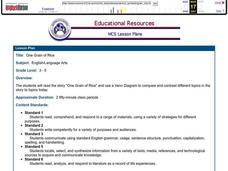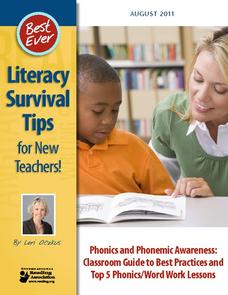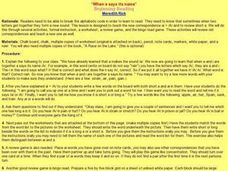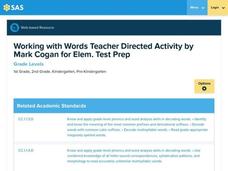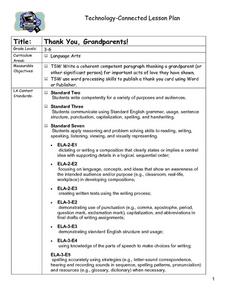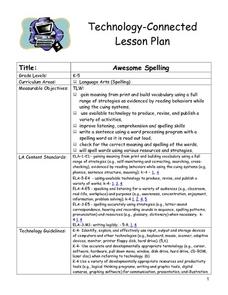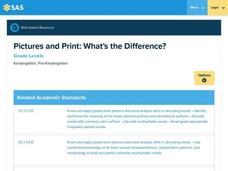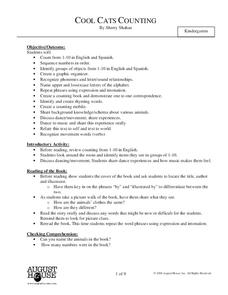Curated OER
Nouns in a Story
Students, assessing a variety of formatting tools with Microsoft Word, utilize a bank of vocabulary words to make a personal dictionary of nouns. They classify nouns for people, places, things and ideas and separate them into common and...
Curated OER
One Grain of Rice
Upper graders read the story One Grain of Rice, and use a Venn diagram to compare and contrast topics found in the story to current event topics today. Groups of three learners work together to create their diagram. The topics they must...
Curated OER
Getting to Know You
After going over the five steps of the writing process, pupils fill out "Getting to Know You" worksheets. They trade papers with each other, and have the task of writing a descriptive paragraph about the person whose worksheet they...
Curated OER
Sun Fun
Students identify that learning letters and their individual sounds are important. They identify the letter u and the sound it can make in various words and illustrations. Finally, students practice wiriting the letter u both upper and...
Curated OER
Bless You
Students practice recognizing the phoneme /a/ in spoken and written words as well as by symbol. They interact with the book, "The Cat Nap," from Educational Insights and the Dr. Seuss book, "ABC's Book." Each student also plays a memory...
Curated OER
Phonics: Read and Write Irregularly Spelled Words
Kids practice saying and identifying words that have irregular spellings. They consider the words said, come, and does by breaking them down into how they are commonly pronounced versus how they "should" be pronounced given their spelling.
Curated OER
Reading and Writing in the Right Direction
Beginning writers practice writing and reading from left to right using green and red dots. You'll need notecards with a green dot on the left side and a red dot on the right side. Do your learners understand that print moves from left...
Curated OER
The Big Sneeze
Students participate in a variety of shared reading and writing activities related to the book "The Big Sneeze" by Ruth Brown. They develop a list of farm vocabulary, sequence the events of the story on a graphic organizer, act out...
International Reading Association
Literacy Survival Tips for New Teachers!
Whether new to teaching or a seasoned pro, this 12-page phonics and phonemic awareness guide is a must for your curriculum library. Everything from a summary of research on the topic to exercises and activities is included.
Curated OER
When A Says Its Name
Students are introduced to the concept of vowel digraphs. They identify the digraph /ai/ in spoken language. After a brief discussion, students apply the rule for reading and spelling words containing the /ai/ digraph by playing word bingo.
Curated OER
Phonics Lessons
Great phonics lesson plans can make teaching students to read a whole lot easier, and a lot more enjoyable.
Curated OER
Mother Goose on the Loose: Teaching Reading and Writing in a Way That's Exciting
Students become familiar with the conventions of print as they recognize Mother Goose poems. In this Mother Goose lesson, students follow the words from left to right as they read Mother Goose poems. Students recognize rhyming words and...
Curated OER
Give a Hoot About Owls
Students research basic information about owls. They complete a class KWL chart, and conduct research on owls using the Internet and a variety of resource books. Next, they write an owl acrostic poem and a report using their research...
Curated OER
The Letterbox Lesson
Students analyze phoneme sequence in a word. They spell words using phoneme analysis and read new words using phoneme analysis.
Curated OER
Number Recognition Games
Students explore number sense by participating in a math recognition activity. In this number identification lesson, students practice pronouncing names of numbers and matching the number with an amount of objects. Students practice...
Curated OER
Word Recognition
Students recognize and spell color and shape words. In this color and shape words lesson plan, students reinforce their vocabulary and spelling skills.
Pennsylvania Department of Education
Working with Words Teacher Directed Activity by Mark Cogan for Elem. Test Prep
Students build word families. In this interactive language arts activity, students visit a website where they play a game creating word families. Students may print out their work when finished.
Curated OER
Thanksgiving History
First graders gain knowledge about the first Thanksgiving, how the pilgrims lived and the differences between our Thanksgiving today and the Thanksgivings of the past. They recognize different parts of the word Thanksgiving.
Curated OER
Thank You, Grandparents!
Students share important moments with their grandparents. Individually, they write one paragraph thanking them for being in their lives or for a specific event they have been involved in. They also identify ways they act like their...
Curated OER
Nursery Rhymes
Young scholars recall details of nursery rhyme read by teacher, identify main characters, and demonstrate knowledge of poem by creating concept map about story that includes title, clip art, and changes in font and color.
Curated OER
Awesome Spelling
Learners are introduced to spelling words as a whole class by viewing a PowerPoint. They spell the word, repeat and spell the word again as a whole class. Pupils create a sentence orally using the list of words. Students work in small...
Curated OER
Spelling Graffiti
Young scholars practice the skill of spelling through using creative art integrated with technology. They use technology by using powerpoint slides for each spelling word. Then students work to create posters for spelling words with...
Pennsylvania Department of Education
Pictures and Print: What's the Difference?
Learners watch a PowerPoint presentation. In this early literacy lesson, students watch a PowerPoint presentation describing print from pictures and the difference between the two.
Curated OER
Cool Cats Counting
Students practice number sense with the book Cool Cats Counting by Sherry Shahan. In this number lesson, students listen to the book and count from 1-10 in English and Spanish. They practice their alphabet, rhyming words, and...



